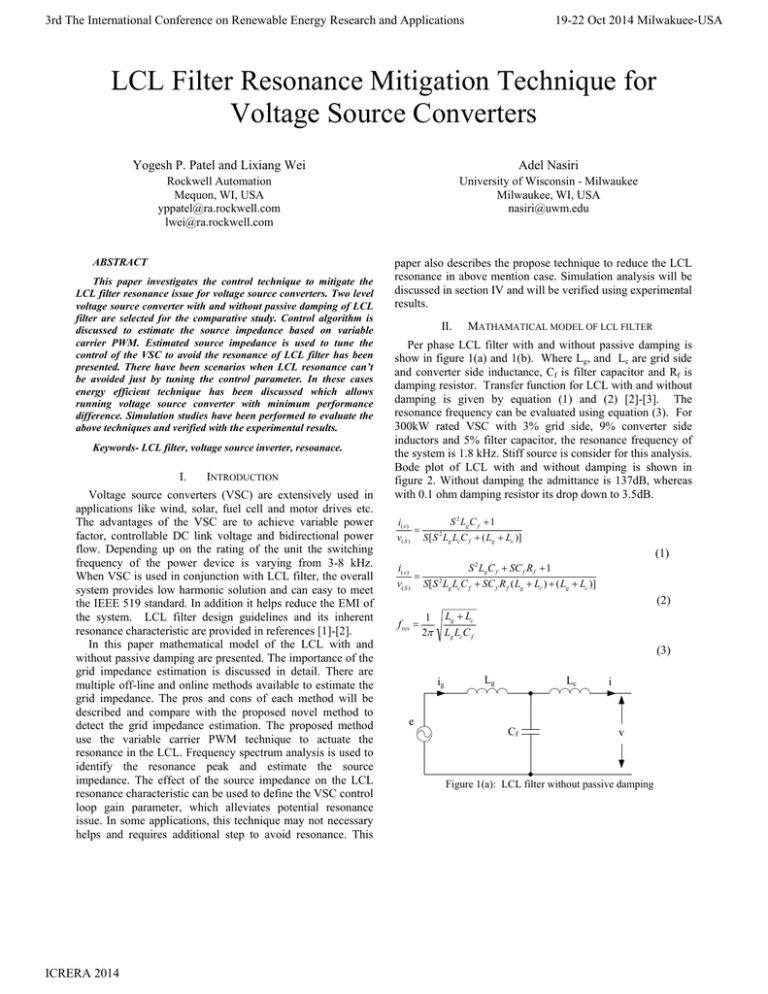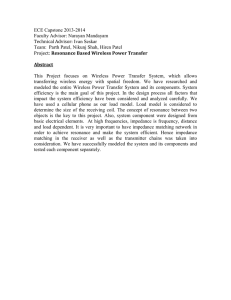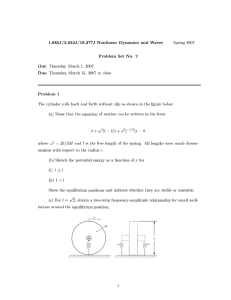LCL Filter Resonance Mitigation Technique for Voltage Source
advertisement

3rd The International Conference on Renewable Energy Research and Applications 19-22 Oct 2014 Milwakuee-USA LCL Filter Resonance Mitigation Technique for Voltage Source Converters Yogesh P. Patel and Lixiang Wei Adel Nasiri Rockwell Automation Mequon, WI, USA yppatel@ra.rockwell.com lwei@ra.rockwell.com University of Wisconsin - Milwaukee Milwaukee, WI, USA nasiri@uwm.edu ABSTRACT This paper investigates the control technique to mitigate the LCL filter resonance issue for voltage source converters. Two level voltage source converter with and without passive damping of LCL filter are selected for the comparative study. Control algorithm is discussed to estimate the source impedance based on variable carrier PWM. Estimated source impedance is used to tune the control of the VSC to avoid the resonance of LCL filter has been presented. There have been scenarios when LCL resonance can’t be avoided just by tuning the control parameter. In these cases energy efficient technique has been discussed which allows running voltage source converter with minimum performance difference. Simulation studies have been performed to evaluate the above techniques and verified with the experimental results. Keywords- LCL filter, voltage source inverter, resoanace. I. INTRODUCTION Voltage source converters (VSC) are extensively used in applications like wind, solar, fuel cell and motor drives etc. The advantages of the VSC are to achieve variable power factor, controllable DC link voltage and bidirectional power flow. Depending up on the rating of the unit the switching frequency of the power device is varying from 3-8 kHz. When VSC is used in conjunction with LCL filter, the overall system provides low harmonic solution and can easy to meet the IEEE 519 standard. In addition it helps reduce the EMI of the system. LCL filter design guidelines and its inherent resonance characteristic are provided in references [1]-[2]. In this paper mathematical model of the LCL with and without passive damping are presented. The importance of the grid impedance estimation is discussed in detail. There are multiple off-line and online methods available to estimate the grid impedance. The pros and cons of each method will be described and compare with the proposed novel method to detect the grid impedance estimation. The proposed method use the variable carrier PWM technique to actuate the resonance in the LCL. Frequency spectrum analysis is used to identify the resonance peak and estimate the source impedance. The effect of the source impedance on the LCL resonance characteristic can be used to define the VSC control loop gain parameter, which alleviates potential resonance issue. In some applications, this technique may not necessary helps and requires additional step to avoid resonance. This ICRERA 2014 paper also describes the propose technique to reduce the LCL resonance in above mention case. Simulation analysis will be discussed in section IV and will be verified using experimental results. II. MATHAMATICAL MODEL OF LCL FILTER Per phase LCL filter with and without passive damping is show in figure 1(a) and 1(b). Where Lg, and Lc are grid side and converter side inductance, Cf is filter capacitor and Rf is damping resistor. Transfer function for LCL with and without damping is given by equation (1) and (2) [2]-[3]. The resonance frequency can be evaluated using equation (3). For 300kW rated VSC with 3% grid side, 9% converter side inductors and 5% filter capacitor, the resonance frequency of the system is 1.8 kHz. Stiff source is consider for this analysis. Bode plot of LCL with and without damping is shown in figure 2. Without damping the admittance is 137dB, whereas with 0.1 ohm damping resistor its drop down to 3.5dB. S 2 Lg C f + 1 i( s ) = 2 v( S ) S [ S Lg LcC f + ( Lg + Lc )] (1) S 2 Lg C f + SC f R f + 1 i( s ) = 2 v( S ) S[ S Lg LcC f + SC f R f ( Lg + Lc ) + ( Lg + Lc )] (2) f res Lg + Lc 1 = 2π Lg LcC f (3) ig Lg Lc i e Cf v Figure 1(a): LCL filter without passive damping 3rd The International Conference on Renewable Energy Research and Applications 19-22 Oct 2014 Milwakuee-USA Figure 1(b): LCL filter with passive damping III. ALGORITHM TO ESTIMATE SOURCE IMPEDANCE The source impedance significantly affects the behavior of the LCL filter response. This will be identify by the bode plot of the LCL filter transfer function with different source impedance as shown in figure 3. In figure 3, Lg includes the source impedance as well as grid side inductance (3% L) of the LCL filter. One can observe that as the source impedance increase, the resonance frequency reduces [4]. If source is more than 20 times the rating of VSC then source impedance is negligible compare to the grid side inductance and has minimum effect on the resonance frequency. Figure 2 : Bode plot of the LCL filter W/WO passive damping For the stiff source, the resonance frequency is 1.8 kHz. In contrary, if VSC is connected to generator, in this case the source impedance is almost 5 times the grid side inductor of the LCL filter. The resonance frequency may drop to 1.1 kHz and the effective bandwidth of the control loop reduces significantly. If the control loop parameter is tuned based on just LCL filter without considering the source impedance, for any step change in load VSC goes to the unstable mode. It is obvious that as source impedance increase, the attenuation of the switching frequency component also increase. This additional attenuation won’t really help the converter because LCL is already designed to provide enough attenuation with stiff source to meet IEEE 519 low harmonic requirement. For better turning of the control loop of the VSC required the information about source impedance [5]-[8]. ICRERA 2014 Figure 3: LCL filter with different source impedance The different approaches to estimate the grid impedance are classified in to offline and online approaches. In offline approach, the grid impedance is measured while inverter is not connected, where as in online approach the inverter is always connected to the grid. The offline grid estimation method discussed in [13] requires additional instrumentation to measure the grid impedance. This method provides accurate measurement but it is not practically possible for grid tie inverter as grid impedance is dynamically changing. The different online approaches are discussed in [4] and [14]. The drawback of these methods are low accuracy and frequent introduction of the disturbance to the system. The proposed variable frequency triangular carrier based PWM technique is simple to implement and used once at installation of the unit to estimate the source impedance. The carrier frequency is sweep from the standard switching frequency of the VSC which is 4 kHz in this case to 1 kHz while VSC is running in close loop mode or in open loop mode based on the control implementation. When the carrier frequency sweeps though the resonance frequency of the LCL unit which now includes source, it starts resonating. Save the input current and voltage waveform at point of common coupling (PCC) with sampling rate at least 5 times standard switching frequency of the VSC unit to memory. As resonance leads to change in characteristic of the VSC parameters like DC bus pump up and increase in input current, the unit can be shut down with either bus over voltage or input over current in event of uncontrolled resonance. Fast Fourier Transform (FFT) analysis can be performed on either input current data or voltage data which provides the information about resonance frequency. This resonance frequency can be used to calculate the source impedance using equation (4) as values of Lg, Lc and Cf are known. Lg = Lc 2 LcC f (2πf res ) − 1 (4) The above measure grid impedance is used for control of the active converter, resonance evaluation, weak grid stability margin analysis and short circuit current level evaluation. Even after considering the source impedance and tune the control loop of the VSC, there are some cases where VSC control cannot avoid resonance. One of the scenarios is shown 3rd The International Conference on Renewable Energy Research and Applications 19-22 Oct 2014 Milwakuee-USA in figure 4 where two drives are connected to same PCC. One drives switching frequency is overlapping to other drives LCL resonance frequency leads to resonance. Figure 4: Two VSC’s connected at same PCC Another scenario where the source impedance is very high approximately 10-15%, which results in distorted input voltage waveform as shown in figure 5 without any load on the inverter. The inverter current in figure 6 shows the significant resonance. The FFT analysis is performed on the line current, which gives total harmonic distortion around 26.33%. The 13th, 14th, 17th and 18th order harmonics are dominating as shown in figure 7. The inverter current control loop turning did not help to prevent this low order resonance. Active or passive damping techniques will require to eliminate the resonance. The active damping control techniques are discussed in references [9]-[12]. The control of the active damping requires higher control bandwidth and sampling rate. For better active damping performance requires higher bandwidth and higher accuracy sensors, low propagation delay and minimum phase shift of the signal. This leads to increase the control complexity and higher cost to the end product. The only easy way to alleviate this problem is by adding passive damping circuit to the unit which is resonating. The passive damping also helps to reduce core loss in converter side inductor. Figure 6: Input current waveform with inverter modulating and no load condition Figure 7: Input phase R current and its FFT analysis General perspective of the passive damping is an additional watt loss and low efficiency of the product. This problem can be solved as shown in figure 8. The damping resistor is in series with the filter capacitor. The contactor or switch is in parallel to the damping resistor. The SW1 is in normally ON position when there is no resonance, which bypass the damping resistor and increase the efficiency of the product. When control system detects the resonance, SW1 will be turn off, which allows putting the resistor in series with filter capacitor to help damping the LCL resonance. The watt loss in resistors occur only if there is resonance. LCL Lg Figure 5: Input voltage waveform of inverter without loading Lc Cf C SW1 VSC Figure 8: LCL damping resistor switching circuit ICRERA 2014 3rd The International Conference on Renewable Energy Research and Applications IV. 19-22 Oct 2014 Milwakuee-USA SIMULATION AND EXPERIMENTAL RESULTS The Simulation study has been performed in Matlab Simulink environment. Simulation results are shown in figure 9 for 300kW VSC with LCL filter (Lc=180uH, Cf=172uF, Lg=60uH) and an additional source impedance of 60uH. Without considering source impedance, the resonance frequency of the LCL filter is about 1.8 kHz. The variable carrier PWM is used to actuate the resonance started with 4 kHz frequency. For simulation purpose the carrier frequency changes in steps but can be varied gradually. When the carrier frequency reduces to 1.65 kHz the resonance is gradually increases and reaches to highest level at 1.3 kHz. The equivalent distortion can be observed on the phase to ground voltage. Frequency analysis is performed on the voltage waveform gives exact frequency of the resonance. This information is used to predict the source impedance. Figure 10 shows the FFT analysis of the voltage waveform. The resonance frequency component is 1.36 kHz. When calculate the source impedance using equation (4), it turn out to be 60uH, which match the source impedance values used for the simulation purpose. When two VSC based drive connected to same PCC, equivalent scenario can be simulated with adding 1.6kHz noise to the source. For simulation purpose, source impedance is ignored. Figure 11 shows that when noise introduce to the source, drive start resonating. When damping resistor is placed in series with filter capacitor by turning off the switch SW1 at time 0.55sec reduce the resonance significantly. FFT analysis of the current waveform is performed on resonance current with and without damping. The THD reduced from 128% to 18% as shown in figure 12. Figure 10: FFT of voltage waveform Figure 11: Waveform W/WO resonance damping Figure 9: Resonance using variable carrier frequency PWM Figure 12: FFT W/WO resonance damping In order to evaluate the effect of the soft source on the converter, experiment is performed using 300kW converter connected to grid using isolating transformer. The isolation transformer is choose such that it provide soft line condition to the converter. Significant resonance is observed as shown in figure 13. By adding damping resistor in series with the capacitor reduce the resonance as shown in figure 14. ICRERA 2014 3rd The International Conference on Renewable Energy Research and Applications [3] [4] [5] [6] [7] [8] Figure 13: Experimental result: Resonance of the LCL filter [9] [10] [11] [12] [13] [14] Figure 14: Experimental result: LCL filter with passive damping V. CONCLUSION In this paper, an algorithm is proposed to estimate the source impedance and deliver the resonance mitigation technique to eliminate the resonance. The main advantage of the proposed algorithm is to estimate the source impedance accurately and use it to tune the control loop to avoid resonance. In some cases if control cannot avoid the resonance then propose resonance mitigation technique is used which switch the damping resistance circuit in series with the filter capacitor. It alleviate the resonance issue and allow VSC to run with reduce performance. It is energy efficient solution because resistor is only in circuit if control cannot avoid the resonance. Simulation results support the propose claim in this paper. In addition the experimental results validate the simulation analysis. REFERENCES [1] [2] M. Liserre, F. Blaabjerg, and S. Hansen “Design and Control of an LCL filter based Three-phase Active Rectifier,” Conf Rec. of 36th IAS Ann. Meeting, Chicago, 2001, pp. 297-307. Y. Patel, D. Pixler, A. Nasiri, “Analysis and design of TRAP and LCL filters for active switching converters,” IEEE industrial electronics international symposium (ISIE), pp 638-643, 2010 ICRERA 2014 19-22 Oct 2014 Milwakuee-USA Wei Sun; Xiaojie We; Peng Dai; Juan Zhou; “An overview of damping methods for three phase PWM rectifier,” IEEE industrial technology, pp. 1-5, 2008 M. Liserre; F. Blaabjerg; R. Teodorescu; “Grid impedance estimation via excitation of LCL filter resonance,” IEEE Trans, Ind. Appl., vol. 43, no. 5, pp. 1401-1407, Sep./Oct, 2007 V. Blasko and V. Kaura, “ A new mathematical model and control of a three-phase AC-DC voltage source converter,” IEEE Trans. Power electronics., vol. 12, no. 1, pp. 116-123, Jan. 1997. Y Lang; X Zhang; D Xu;, S. Hadianamrei; H Ma, “Nonlinear Feed forward Control of Three-phase Voltage Source Converter,” IEEE Industrial Electronics., vol. 2 pp. 1134-1137, Jul 2006 [7] Xu Lie; Zhi Dawei; Yao Liangzhong; “Direct power control of grid connected voltage source converters,” IEEE Power engineering society general meeting, pp. 1-6, 2007 Li Wei Yun, “ Control and resonance damping of voltage source and current source converters with LC filters,” IEEE Trans, Ind. Appl., vol. 56, no. 5, pp. 1511-1521, May 2009 M. Loserre, A. Dell’Aquila, F. Blaabjerg, “Genetic algorithm-based design of the active damping for an LCL filter three phase active rectifier,” IEEE Trans. Power electronics., vol. 19, no. 1, pp. 76–86, Jan. 2004. V. Blasko and V. Kaura, “A novel control to actively damp resonance in input LC filter of a three-phase voltage source converter,” IEEE Trans.Ind. Appl., vol. 33, no. 2, pp. 542–550, Mar./Apl. 1997. R. Teodorescu; F. Blaabjerg; M. Liserre; A. Dell’Aquila, “A stable three phase LCL filter based active rectifier without damping,” IEEE industrial applications conference, vol. 3, pp. 1552-1557, 2003 Tang Yi; Loh Chiang Poh; Wang Peng; Choo Hoong Fook; Gao Feng; “Exploring inherent damping characteristic of LCL filters for three phase grid connected voltage source inverters,” IEEE Trans, Power electronics., vol. 23, no. 3, pp. 1433-1443, Mar 2012 Gasperi, M.L., Jensen, D.L., Rollay, D.T., "Method for AC Powerline Impedance Measurement", Industry Applications, July-aug. 2008, pp. 1034-1037 Lucian Asiminoaei, Remus Teodorescu, "A Digital Controlled PVInverter With Grid Impedance Estimation for ENS Detection". IEEE TRANSACTIONS ON POWER ELECTRONICS, VOL. 20, NO. 6, NOVEMBER 2005. pp.1480-1490



